THE CONTEXT: 5G, the next-generation network service was launched in India by the Prime Minister at the sixth edition of India Mobile Congress (IMC) held on 1 October 2022 in New Delhi. With the launch of 5G services, India joins the list of around 70 countries with the next generation of the telecom standards.
ABOUT 5G TECHNOLOGY FOR MOBILE DEVICES.
BASICS: 5G cellular networks are up to 100 times faster than 4G. Faster connectivity speeds, ultra-low latency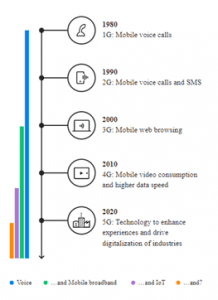 (time taken between performing an action and getting a response) and greater bandwidth are helping in advancing societies, transforming industries and enhancing day-to-day experiences.
(time taken between performing an action and getting a response) and greater bandwidth are helping in advancing societies, transforming industries and enhancing day-to-day experiences.
5G EVOLUTION:
- The 1G era was defined by briefcase-sized phones and short conversations between a relatively small number of professional people.
- During 2G era, the demand for mobile services grew and never slowed down.
- Phones that could fit in your pocket, SMS and mobile internet access were hallmarks of the 3G world.
- 4G is the era of smartphones, app stores and YouTube.
- 5G will completely reshape both our professional and personal lives by enabling new use cases like connected vehicles, Augmented Reality and enhanced video and gaming.
DIFFERENCE BETWEEN 4G AND 5G MOBILE NETWORK TECHNOLOGY
4G TECHNOLOGY
- Uses lower reading frequencies of 700 MHz to 2500 MHz.
- Low speed with less data transfer.
- Latency: the delay before a transfer of data begins following an instruction.
- Higher latency as compared to 5G that is about 20-30 milliseconds.
- Supports a lesser number of devices (about 4,000 devices per square kilometre).
- Has led to more congestion and lesser coverage.
5G TECHNOLOGY
- Uses much higher radio frequencies of 28 GHz.
- Faster speeds with more data transfer.
- Has lower latency which is predicted to be below 10 milliseconds, and in best cases around 1 millisecond.
- Uses a millimetre-wave spectrum which enables more devices to be used within the same geographic area supporting around one million per square kilometre.
- It uses a new digital technology that improves coverage, speed, and capacity.
5G NETWORK ARCHITECTURE: A mobile network has two main components, the ‘Radio Access Network’ and the ‘Core Network’.
The Radio Access Network:
- It consists of various types of facilities, including small cells, towers, masts and dedicated in-building and home systems that connect mobile users and wireless devices to the main core network.
- Small cells will be a major feature of 5G networks, particularly at the new millimetre wave (mmWave) frequencies where the connection range is very short. To provide a continuous connection, small cells will be distributed in clusters depending on where users require connection which will complement the macro network that provides wide-area coverage.
- 5G Macro Cells will use MIMO (multiple input, multiple output) antennas that have multiple elements or connections to send and receive more data simultaneously. The benefit to users is that more people can simultaneously connect to the network and maintain high throughput.
The Core Network: It is the mobile exchange and data network that manages all of the mobile voice, data and internet connections. For 5G, the ‘core network’ is being redesigned to better integrate with the internet and cloud based services and also includes distributed servers across the network improving response times (reducing latency). Many of the advanced features of 5G including network function virtualization and network slicing for different applications and services, will be managed in the core. The pictorial representation given below shows local cloud servers providing faster content to users and low latency applications for vehicle collision avoidance systems.
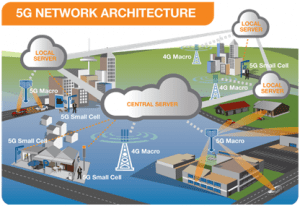
Example of a local server in a 5G network providing faster connection and lower response times
- Network Slicing: enables a smart way to segment the network for a particular industry, business or application. For example emergency services could operate on a network slice independently from other users.
- Network Function Virtualization (NVF): It is the ability to instantiate network functions in real-time at any desired location within the operator’s cloud platform. NVF is crucial to enable the speed, efficiency and agility to support new business applications and is an important technology for a 5G ready core.
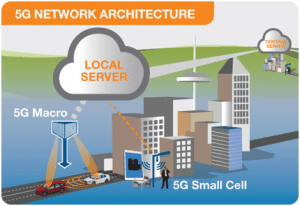
Different Bands of 5G
5G primarily operates across three bands: low, mid, and high-frequency spectrums, each with its benefits and drawbacks.
- Low Band Spectrum: The maximum speed of Internet and data exchange is limited to 100 Mbps in terms of coverage and speed (Megabits per second). This means that telecom companies can use and install it for commercial cellphone users who may not have specific demands for very high-speed Internet. However, the low band spectrum may not be optimal for the industry’s specialised needs.
- Mid-Band Spectrum: It has faster speeds than the low-band spectrum, but it has restrictions regarding coverage area and signal penetration. Industries and specialised production units could utilise this band to create captive networks that can be tailored to their specific demands.
- High Band Spectrum: The fastest speed of all three bands, but its coverage and signal penetration intensity are severely limited. This band significantly improves future 5G technology applications such as the Internet of Things (IoT) and innovative technologies, although it has significant infrastructure requirements.
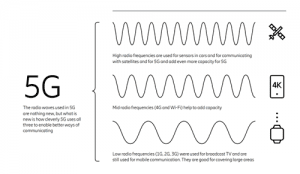
5G AROUND THE WORLD: Since being launched in 2019, 5G is introduced in around 70 countries as of June 2022. China and the United States are the countries with the most 5G cities. But on a regional basis, the Europe, Middle East and Africa (EMEA) region has surpassed the Asia Pacific region (including China) in terms of deployed 5G networks. The graph given below depicts the countries with the most number of cities with 5G technologies in the world.
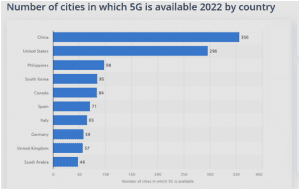
ADVANTAGES OF 5G TECHNOLOGY:
- With very high speed, 5G allows access to high-bandwidth multi-media such as HD videos, movies and games, which can be downloaded in seconds.
- It enables high-speed data services that have industrial applications and also supports critical applications like financial transactions and healthcare.
- It will help incorporate Artificial Intelligence (AI) into our daily lives. It will enable cloud systems to seamlessly stream software updates, music, and navigation data to driverless cars. It will also facilitate vehicle-vehicle communications to keep a safe distance from each other leading to fewer car accidents and less traffic congestion.
- Broadband Internet of Things (IoT) takes things up a level.This will allow for: The use of drones for everyday activities such as the delivery of retail goods or medical supplies; Tracking of traffic patterns in relation to an organisation’s delivery schedules; Smarter electricity grids for greatly reduced carbon emissions.
CHALLENGES FOR THE ADOPTION OF 5G TECHNOLOGY FOR INDIA
DIGITAL DIVIDE
- 5G will not necessarily bridge the digital divide among the rural and urban areas in the short term, rather increase it as the business case of 5G, even in urban areas does not have maximum accessibility. Therefore, it will not be easily available in rural areas too.
SECTOR-SPECIFIC
- The rollout of 5G technology will be different from the one seen in 4G; it will be introduced in specific sectors and areas in the initial phases and will be a niche service unlike 3G and 4G, which were pervasive services. 5G will get intensified over a comparatively longer period of time.
INROADS OF 4G
- The consumers are still grappling with basic network issues like call drops and interrupted data services. We still have areas where 4G networks have not stabilised causing frequent disruptions in internet services. It is important to meet the quality of service parameters of existing 4G networks before embarking on a new 5G platform.
CRITICAL INFRASTRUCTURE
- 5G will require a fundamental change to the core architecture of the communication system. The major flaw of data transfer using 5G is that it can’t carry data over longer distances. Hence, even 5G technology needs to be augmented to enable infrastructure.
GOVERNMENT SUBSIDIES
- The likelihood of government subsidies is low as is evident from the history of high reserve prices set by the governments for spectrum auctions amid ongoing fiscal deficits.
FINANCIAL LIABILITY
- For the transition from 4G to 5G technology, one has to upgrade to the latest cellular technology, thereby creating financial liability on consumers as well as service providers.
CAPITAL INADEQUACY
- Lack of adequate capital with suitable telecom companies (like Bharti Airtel and Vodafone Idea) is delaying the 5G spectrum allocation.
THREATS FROM THE 5G TECHNOLOGY
DATA HACKING
- The increased risk of hacking of data is one of the immediate concerns of 5G. Hackers can use mobile and external IP networks for spying and stealing data.
- The use of common Internet protocols such as HTTP and TLS in 5G also lowers the entry barrier for hackers. This could be a potential means for cyberattacks.
- The risk also increases as more and more poorly secured IoT devices are used.
NATIONAL SECURITY
- From a national security perspective, potential targets in 5G networks include critical information infrastructure (CIIs) and mission-critical and nationally important networks.
- The proliferation of Unmanned Aerial Vehicles (UAVs) – commonly known as drones – is a sure-shot consequence of the 5G rollout. The threat of automotive cyber-attacks through 5G networks will also rise.
INTERFERENCE WITH AIR TRAFFIC
- 5G also interferes with airplanes’ radio altimeters, which give readings of the height above the ground during a flight’s approach. This is critical during poor visibility and for aircraft flying at low altitudes.
THE WAY FORWARD:
- Domestic production and internal security:
- Domestic procurement shall be made mandatory for all 5G equipment. The inclusion of 5G in the PLI scheme will also enable domestic procurement.
- India needs to adopt the requisite standard for 5G services to address security concerns. The Mandatory Testing and Certification of Telecommunication Equipment (MTCTE), under which Indian OEMs (original equipment manufacturers) get certified by the government, should be extended to 5G equipment as well.
- To encourage that the spirit of Atmanirbhar Bharat is followed when it comes to the 5G rollout, there is a need to work closely with startups/MSMEs, academia, telecom service providers and the industry in the setting up of R&D Centres.
- Bridging the Rural-urban Gap: The low band spectrum range is much longer, which is helpful in the long distance communications and for rural and far-off places. 5G shall be deployed at different band spectrums which will benefit the rural areas and enhance the wide coverage in lesser time.
- Band Spectrums: The government has complete control over the 5G band spectrum. By managing the design of the spectrums, the government can control the price to be paid by the people. The government can also support the telecom companies to roll out networks that are sustainable and affordable for the public.
- As the deployment of the 5G network is expensive, both the Central and State governments may need to consider measures that aid fibre investment, attract investment through public-private partnerships (PPPs), and facilitate investment funds on a nominal interest basis. The government shall also consider allowing 100% foreign direct investment in the telecom sector along with other policy reforms which will attract investment into the sector.
- Level playing field: The imminent 5G networks demand massive investment and upgradation of sophisticated operations. A level playing field for the relevant operators and honest incentives shall be provided to operators to embrace new technology.
THE CONCLUSION: 5G Technology has ushered in a new era in the technology sector around the world. As far as the nationwide deployment of the technology is concerned, India still has a long way to go. Bringing down the spectrum prices and bridging the rural-urban gap by increasing the accessibility of networks to hinterlands are a few key areas which the government shall focus upon from making the technology a niche.
Mains Practice Questions:
- Discuss the advantages and challenges of 5G technology for India.
- With the advent of the 5G technologies, the data is at risk. What measures the government should adopt for the protection of critical data?

